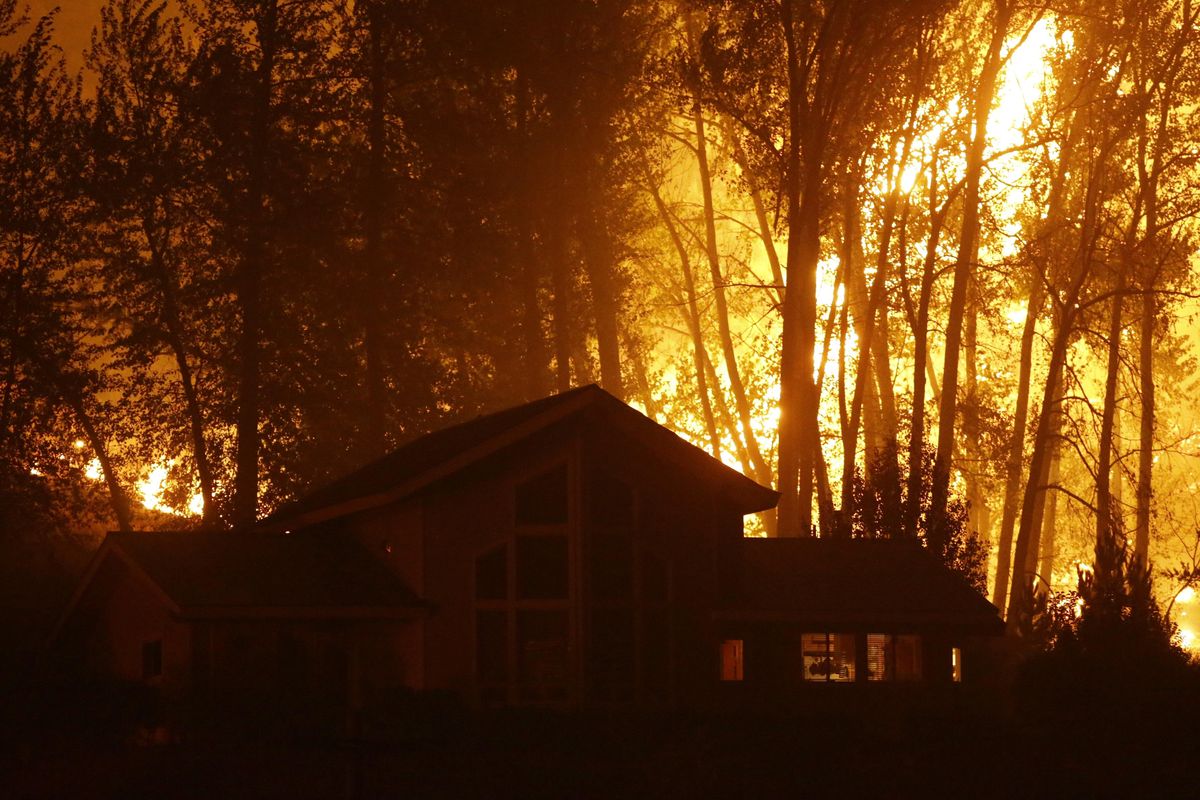Review of fatal Twisp fire calls for more training, possible change to policy on protecting rural homes

Crews near Twisp were working to protect homes on a dead-end road when they were overrun by a wildfire in 2015.
Three U.S. Forest Service firefighters died that day, leading to a first-of-its-kind examination of the event and, potentially, new guidelines about the lengths to which crews should go to protect rural homes.
“Unless we improve the way we fight fire, the lethality demonstrated here may continue to increase in probability,” the “after-action review” states.
Former state Lands Commissioner Peter Goldmark said in a December interview that Washington needs to better prepare communities and landscapes for fire.
He added, “There are some areas that are just too dangerous to go into when there is fire in the landscape. If there’s only one way out – we saw the consequences.”
An after-action review of a fatal incident is normal, but this time the Forest Service teamed up with the Washington state Department of Natural Resources for a learning review. The learning review is a relatively new process, and the reports issued last month are the first completed with two agencies.
High temperatures and drought created an explosive fire season in Washington in 2015, drawing firefighting crews from around the region and from other states. Crews that responded to the Twisp River fire that started on Aug. 19, 2015, included local fire districts, the Forest Service, the Department of Natural Resources and firefighters called in from Colorado to help with Washington’s fires.
“One of the goals of a learning review is to focus on just the particulars of what happened and what we can learn from it,” Forest Service spokesman John Haynes said. “It’s not a process designed to find who is responsible or to point blame.”
DNR and the Forest Service often work together on fires and need to work together on fixing problems, said Goldmark, who left office at the end of December.
“It was a pretty exhaustive and lengthy process, in part because of the emotional entanglement,” he said. “In the past, reports have been more about the shortcomings of individuals. We need to address the issues, understand what the conditions were at the time.”
The report includes a narrative of what happened that day in the words of the firefighters who were there, though their identities are masked by pseudonyms.
“We did those interviews with a measure of anonymity so they could feel free to speak freely,” Haynes said.
Besides urging a possible rethinking of the practice of trying to save homes on dead-end roads, the learning review recommended more training and having weather experts on-site.
Firefighter Daniel Lyon, who survived with severe burns, was one of those calling for more training. He was in his first fire season and said he didn’t feel prepared for the job. He completed three online courses and a one-day “live fire” exercise before he began work.
Weather experts had predicted a shift in the wind the afternoon of the Twisp River fire, but the incident commanders were not aware of that fact, the report states.
Firefighters also reported radio problems. They weren’t all on the same frequency, and people on the ground had difficulty communicating with tankers and helicopters in the air dropping water and fire retardant. When the wind shifted, the radio was so overloaded with traffic that there was difficulty in communicating the danger to crews.
Changes in how fires are fought means there will be a need for more firefighters, Goldmark said. “We need to invest more in our training and we need to invest more in our staff,” he said. “That all takes dollars. As we know, the state budget is crimped; the federal dollars are crimped.”
Most of the issues raised in the report don’t have a quick fix, Haynes said. “We’ve assigned each of these areas to some responsible folks to look at them to see how best to address them moving forward,” he said. “Everything that’s in the report is going to be looked at before the next fire season. We will move forward with what makes the most sense.”
The one question the report does not answer is how one member of a four-man crew of Forest Service firefighters managed to escape while the other three died in their engine, which had run off the side of the road while they tried to escape through the fire.
The report does note, however, that the door handles and linkages in the doors of the engine are made of materials that begin to melt at 446 degrees Fahrenheit. At least one door was working when Lyon jumped out immediately after the engine crashed to a stop, but an examination of his clothing indicates he was exposed to temperatures between 1600 degrees and 1800 degrees for a few seconds during his escape.
“These are questions that plague us,” Goldmark said. “I don’t think anybody knows the answer to that. One person was able to get out and get down the road. That was nothing short of a miracle.”